The Microsoft Surface Laptop 3 (15-Inch) Review: AMD Ryzen Surface Edition
by Brett Howse on October 21, 2019 9:00 AM EST- Posted in
- Laptops
- AMD
- Microsoft
- Surface
- Ryzen
- Surface Laptop
- Surface Laptop 3
GPU Performance: Vega 9
By offering a Vega-based GPU in its laptop products, AMD has raised the bar in terms of what kind of graphics performance should be expected in a thin and light design. Microsoft collaborated with AMD to create a unique variant of their normal Ryzen as well, offering one CU more in both the Ryzen 5, moving it to 9 Vega CUs, and the Ryzen 7, moving it to 11 Vega CUs.
As to how much extra performance that will bring, that is an open question; the absolute maximum is about 10%, but in reality, with the constraints of TDP and CPU speeds, it's likely not a huge jump over the normal Ryzen APUs found in other manufacturers devices. In reality, this is more about putting a stamp on the partnership that AMD has with Microsoft now, than a truly special processor in terms of graphics performance.
That’s not a big stretch either, since AMD already works with the Xbox team on their custom processors, and Microsoft’s Surface team has leveraged that relationship to not only give AMD a design win in an important product, but also providing the Surface team with a unique product that their competition won’t be able to utilize. Microsoft being Microsoft though still has a wide range of PC partners, and assured us that any Windows tweaks they have done to leverage this processor will be a benefit to any other laptops running Ryzen.
To see how the Ryzen 5 3580U handles GPU tasks, it was run through our Ultrabook set of gaming tests, along with a couple of additions as well to get a better feel for the GPU prowess. Gaming on a 3:2 aspect ratio device can be a bit of a challenge though, since not all games support the non-standard resolution, but if necessary you can manually set the device resolution to 1920x1080 to get around this. It doesn’t support 1366x768 though, but 1280x720 is available.
3DMark
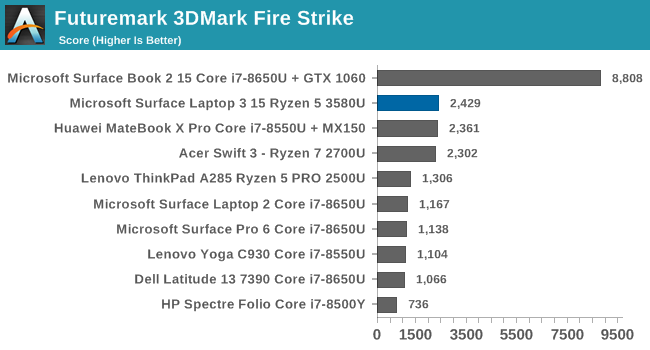
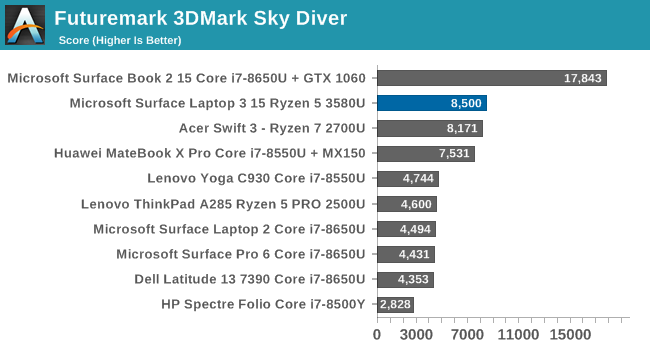
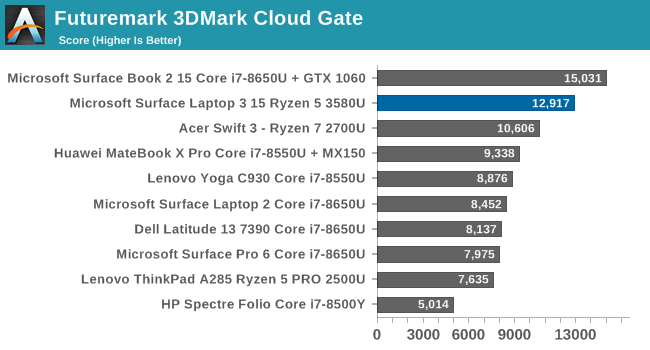
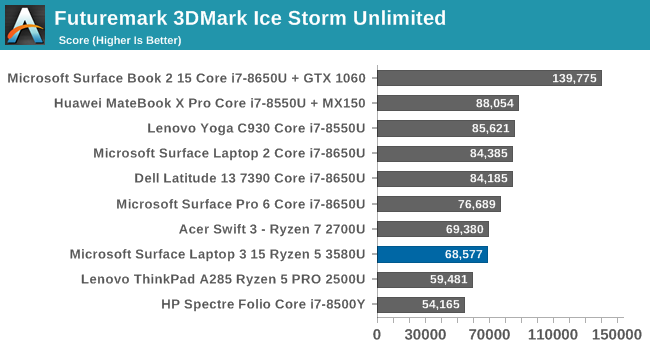
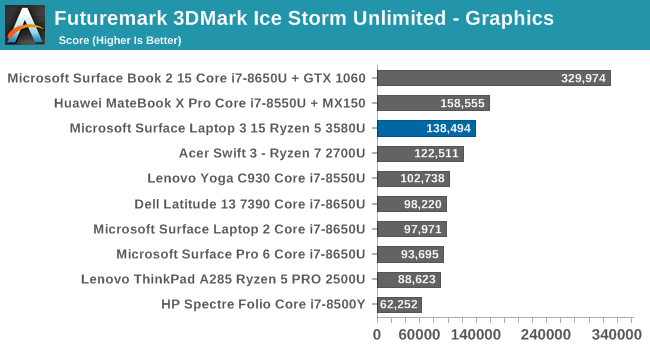
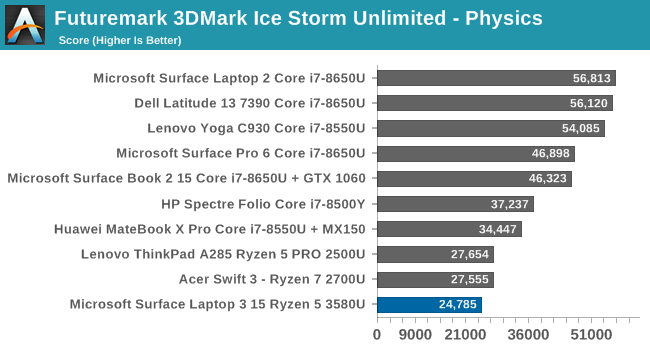
3DMark offers a wide assortment of DirectX tests, from the gaming focused Fire Strike down to the mobile focused Ice Storm Unlimited. For the Surface Laptop 3, the Picasso platform from AMD offers a solid return on investment, often outperforming the Ryzen 7 2700U despite having a slightly weaker GPU. The extra CPU performance help to eliminate some of the bottlenecks that the original Raven Ridge APU was suffering from.
Fire Strike is the test which mostly favors GPU performance, since it’s the most complex scene, and the Ryzen Surface Edition squeaks past the Core i7-8650U plus NVIDIA MX 150 combination in the Huawei MateBook X Pro. That gap remains or grows in both Sky Diver and Cloud Gate, but the mobile focused Ice Storm Unlimited results shows how much quicker the Intel processor is in that highly CPU bound test.
GFXBench
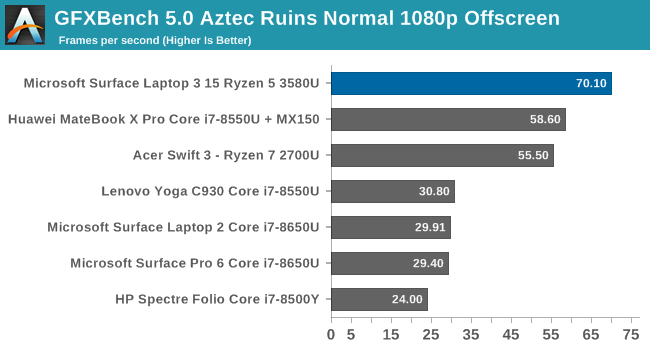
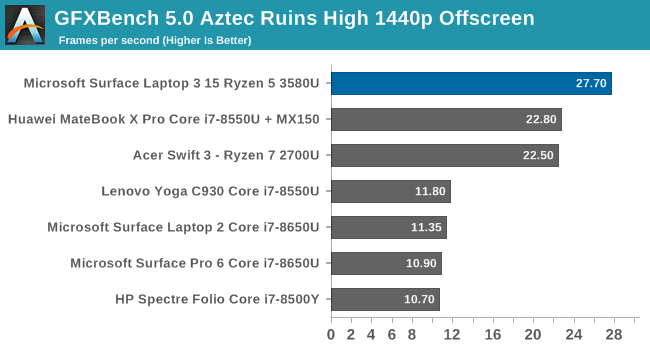
AMD’s work on low-level APIs paid dividends for them in DX12, which is the API used in the latest GFXBench tests. Here the Ryzen Surface Edition pulls a noticeable lead over the previous generation APU, and unsurprisingly a wide lead over the integrated graphics on the 8th generation Intel parts.
Dota 2
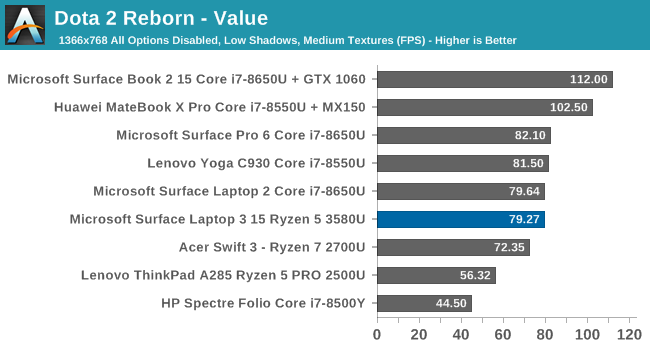
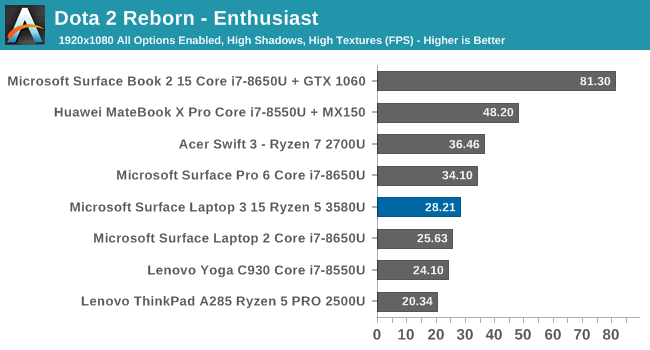
Valve’s Dota 2 can be run on a wide-range of devices, including those with integrated graphics. It’s also very much a CPU bound game so it can really highlight CPU performance on an integrated APU with a shared TDP. In our first real-world gaming test, the Surface Laptop 3 is held back by the CPU.
Tomb Raider
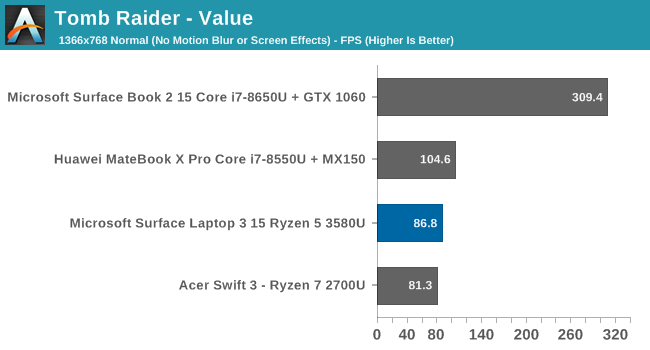
The original Tomb Raider is quite old now, but makes for a good test for a new laptop with integrated graphics. The Ryzen 5 3580U manages to outperform the Rynen 7 2700U here despite the smaller Vega GPU on the Ryzen 5, but can’t quite match the Intel plus NVIDIA combo on the MateBook X Pro.
Rise of the Tomb Raider
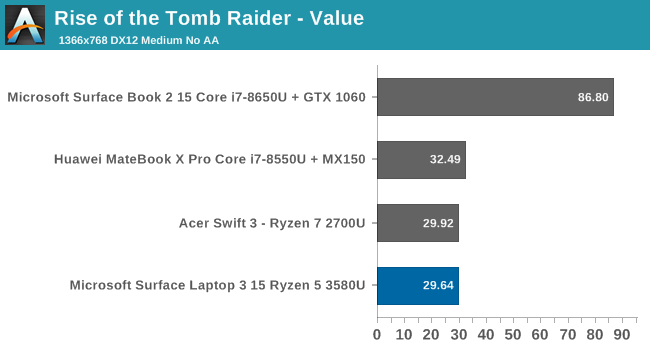
The second installment in the new Tomb Raider series does leverage DX12, but even on our value settings is only barely playable on these devices.
Civilization VI

You don’t need a lot of framerate to play Civ VI, since it’s turn based and not reliant on lightning quick reflexes, but this game struggled with the 3:2 aspect ratio on the display and wouldn’t run at less than 1920x1080, meaning it was still unplayable on the Surface Laptop 3.
GPU Conclusion
The addition of an extra Vega core in the semi-custom Ryzen APU does help in some scenarios, but is still somewhat held back by the Zen CPU cores in real-world games. That being said, it still offers a big performance gain over any of the older integrated Intel GPUs. As expected, the semi-custom nature of this APU is more about highlighting the partnership than any truly revolutionary new product.


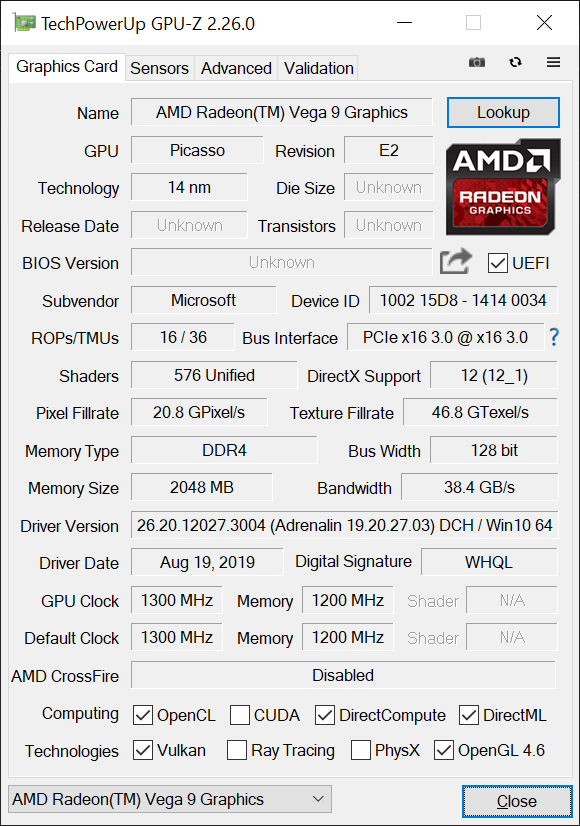








91 Comments
View All Comments
evernessince - Tuesday, October 22, 2019 - link
You make it sound like last gen Intel mobile products are such a step back when in fact they are identical to current products on the market and Intel's "next-gen" products as well. The performance gains have piddling at best. 8 and 9th gen products for all intents are purposes are the same architecture and nm process. You also left out the fact that an R5 mid range processor is beating some of Intel's i7 high end processors in CPU performance. Battery life could be better but have you done the calculation of performance per mAH of the battery? Or are you just assuming with considering the size of the battery and the performance being afforded? How do Intel laptops with similar performance characteristics and battery size fare? Like any laptop, battery life is dependent on more then just the chip on the device.Your comment is misleading, intentional or otherwise.
0ldman79 - Sunday, December 15, 2019 - link
Nah, AMD's battery life still isn't up to par against Intel's 25th Skylake revision, not even the original release.AMD is kicking ass on the desktop but the mobile front is still a bit much. Intel has spent billions making laptops more efficient. They've done well. They got the laptop market under their thumb, even today, while they've effectively lost the performance desktop battle.
The_Assimilator - Monday, October 21, 2019 - link
Not sure why AMD had such a hard-on to get a CPU that is evidently not mobile-focused, into an extremely mobile form factor. No support for LPDDR4, no built-in WiFi, and an iGPU that isn't powerful enough to make any tangible difference to an Intel offering, just makes for a "why".Irata - Monday, October 21, 2019 - link
Oh, Ryzen's iGPU does offer a tangible real life difference if the reviewer choses to include the right benchmarks and also show's the Intel iGPU results for them.Tech Report's and Computer Base's Ryzen 2500u review do and they show that the tangible difference is 50 to over 100% better fps, greatly better frame times, i.e. the difference between a game being playable, or not.
TheinsanegamerN - Tuesday, October 22, 2019 - link
If you have to include “the right benchmarks” to make your APU look good, your product sucks, and you are engaging in the very behavior you accuse anandtech of. Hypocritical.evernessince - Tuesday, October 22, 2019 - link
Well that depends. The sample size is this review is rather small. Very small in fact. Adding more certainly wouldn't hurt. It's less about adding the right benchmarks then it is getting a more reliable dataset. If another review is showing data that more appropriately demonstrates the GPU's capability, that indicates that perhaps the test suite used here is not ideal.Irata - Thursday, October 24, 2019 - link
With "the right" I mean proper benchmarks.One of the advantages of having a better iGPU is that it allows you to do things that you cannot do with a weaker iGPU. Casual gaming, particularly e-sports titles come to mind. Same for any GPU accelerated software.
If you do not include any of those in a review (e.g. just compare them on the basis of surfing the web and watching a few videos), then you are hiding these advantages.
MS segmented their surface laptops into "business" (Intel) where the better battery life is an advantage when you are using it for email, powerpoint, Word, Excel but most likely not causal gaming or content creation.
For this you have have the AMD based consumer platform with its faster iGPU - have a look at the PC mark scores to see how it scores there. You can also check other reviews for Laptops with other Ryzen APU to see that they do offer a tangible advantage over Intel's iGPU when it comes to being able to still play a game or not.
That advantage is paid for with lower battery life in idle / low load situations (not necessarily true for higher load), so it really comes down to what is more important to you. I know that for my work laptop, I would value the extra battery life, for a personal one the ability to do a bit of casual gaming would be worth having a shorter battery life (which is still decent, we are not talking Bulldozer here).
So not hypocritical imho. Just pointing out that a review should include tests for what it was built for / is aimed at.
m53 - Wednesday, November 20, 2019 - link
All the benchmarks I have seen so far, the ice lake iGPU is equal or better than AMD APUs for same TDP. On the otehr hand the CPU is tangibly faster with much better battery life and connectivity (wifi6 built-in).Fulljack - Tuesday, October 22, 2019 - link
Intel doesn't have built-in wifi either. current offering actually still use smaller RF module, due to Intel CNVi. I don't get why Microsoft doesn't release AMD with latest ax chipset, because Intel AX200 does works on AMD system too.GreenReaper - Tuesday, October 22, 2019 - link
Surely it's because it costs more, and this is meant to be the more affordable option?